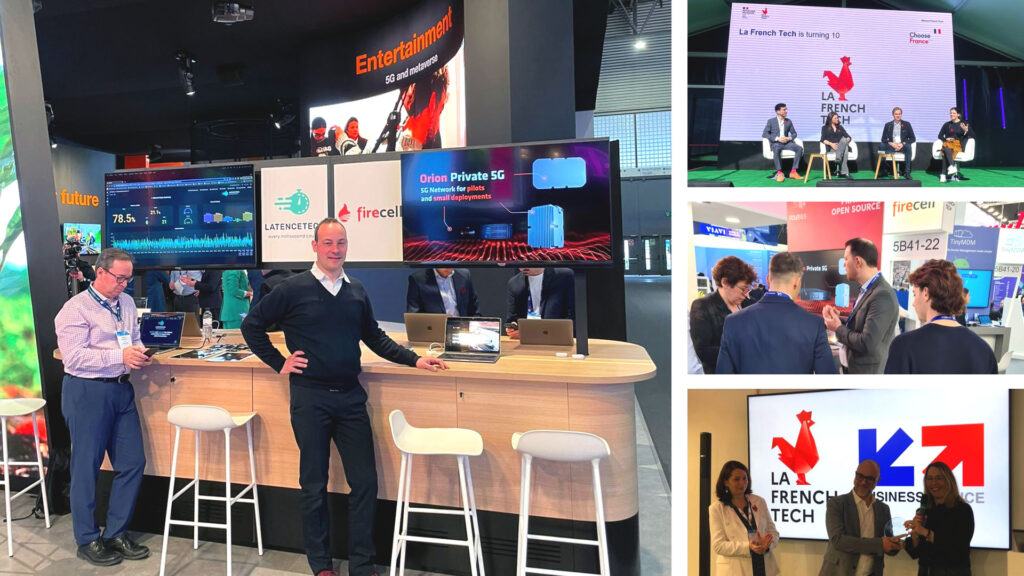

After a successful wrap-up of MWC 2023 here are some of our reflections and observations. From our point of view, this MWC was a world of contrasts. There was plenty of discussions around why the public 5G networks are not transitioning to 5G Standalone or Real-5G but at the same time there were demos of 6G and how it will enable real-time communications. As an analyst put it, we have seen this same storyline during early 5G days.
This is not to say that there was a lack of innovation or not enough buzz. The GSMA put the attendee numbers at over 88,500 and it felt like even more from our booth. While we were present at our booth in The French Pavilion for all four days, we were also present at the Orange booth for a day, as part of the Orange Fab accelerator. We were extremely busy throughout the event.
We were especially delighted to have been awarded startup of the year which was organized by Business France, Pôle SCS, and Orange fab. Every year, they select the most innovative startup in their ecosystem and this year Firecell was fortunate enough to be selected.
Here is a quick summary of some of the interesting things our team noticed at MWC this year:
Devices: There were just too many devices to talk about in this post. We noticed a lot of new foldable phones and even rolling displays. There were plenty of smart glasses and head mounted devices (HMDs) that may play a significant role in the future. Some devices and other modules were also touting eSIM capabilities that are expected to simplify not only users lives in public networks but also simplify non-public networks (NPNs) rollouts.
6G: There were quite a few 6G demos in addition to the keynotes, talks and other whitepapers. Digital Twins and Metaverse featured heavily in most 6G discussions but there were also mentions of AI (Artificial Intelligence), RIS (Reconfigurable Intelligent Surfaces), THz (terahertz) frequencies, Quantum security, Human Augmentation, etc.
The life scale UAM (Urban Air Mobility) aircraft simulator with VR (Virtual Reality) demo from the South Korean mobile operator SK Telecom was probably the most popular demo at MWC. This was apparent from the long queues that were visible throughout the four days to experience it.
5G: 5G was the main attraction at the show. There were announcements of new hardware with 128T128R massive MIMO radios and we even heard a mention of 256T256R. There was a mention of massive MIMO radios becoming lighter and even consuming less power, thanks to the advancements of silicon and AI software.
In addition there were live demos and prototypes of 5G NR Non Terrestrial Networks (NTN) connectivity that are part of 3GPP Release-17 specifications. Multiple chipsets, devices and satellite service providers were involved in the demos to highlight that this is going to be available on devices sooner or later. While 5G NR-NTN will help eradicate the not spots and help with emergency communications, it remains to be seen if the same solution can work reliably for IoT and V2X communications.
A question that was asked multiple times was the lack of 5G Standalone (SA) networks rollout. While the Non-Standalone (NSA) was supposed to be an interim solution until the 5G Core (5GC) was ready to be deployed, the transition to a cloud-native solution has been a challenge for many operators. Many operators have started the journey to a combined core that can handle EPC as well as 5GC signaling to make the network operations simpler, efficient and automated. We expect many more announcements on 5G SA later this year.
Robots: Robots were visible everywhere. Demos included the usual robot baristas, guidance robots, surveillance robots, healthcare assisting robots, delivery robots, humanoid robots and even robo-dogs. Many companies have adopted the mantra that “robots are the future”, underpinned of course by the advancements in connectivity.
Open RAN: Open RAN has a great momentum behind it at the moment so no doubt it was present on many different stands, booths and talked about in various sessions. The first keynote at MWC was titled ‘Vision of an Open Future’ featuring speakers from Telefonica, Orange and the European Commission.
There were several announcements about new chipsets, virtualized DU and CU software, more O-RAN compliant RUs (O-RUs), new accelerator cards (both In-line and look-aside), lessons learned from earlier deployments and operator commitments to continue their Open RAN deployments. A lot of buzz was created due to the Telecom Infra Project’s pavilion and the O-RAN Alliance Ecosystem briefing on day 2 which was well organized and widely attended by analysts and journalists.
There were also network-in-a-box (NIB) demos featuring open source software to create a complete 5G solution that can be made available to developers and for PoC demonstrations. Some of these were based on low-power platforms like Raspberry Pi that will have no real-world use cases though.
Metaverse, Games and Extended Reality (XR): No show can be said to be complete without the applications demonstrating the end-to-end network capabilities. There were keynotes dedicated to the future of sports & entertainment, games and metaverse. While many of these use cases rely on Wi-Fi connectivity, there is a user demand for similar experience outdoors and on the move. 6G proponents also brought up the point that the data requirements may not be satisfied with just network modernization and 5G, we may have to wait for the next-generation to meet some of the extreme requirements.
Private Networks: We saved the best for the last as this is our area of expertise. While there were announcements and demos of many different private networks use cases, many enterprises were keen to learn more about private networks in general. There are many different use cases where enterprises feel they can complement Wi-Fi with private 4G/5G. The biggest barrier for these enterprises to adopt private 4G/5G networks has been a lack of understanding and the initial Capex. While there was a scant mention of private 4G networks, they do still make a big chunk of deployments due to a reasonably priced and mature device ecosystem.
The regulators and policy makers are realizing the benefits of the enterprises’ move to secure private networks and more spectrum is being made available in many different countries with much less barriers to obtaining a license.
At Firecell, we aim to democratize Private 4G & 5G networks by making them as simple and affordable as Wi-Fi. We achieve this by making our Open RAN 4G & 5G private networks solution agnostic to hardware, thereby bringing the overall network cost down. Whether you wish to test your own use cases, start a pilot within your own facilities or launch a private 5G network in your facilities, we have a solution for you.
Please get in touch for more information.